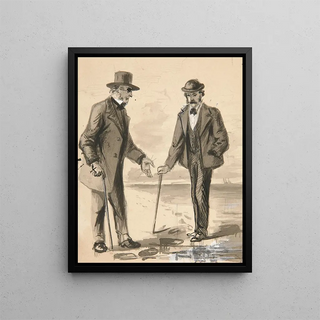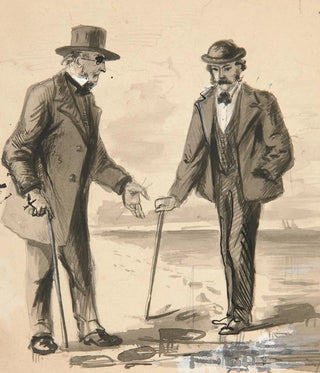Art print | Two men conversing by the sea - Edwin Austin Abbey


View from behind

Frame (optional)
In the world of art, some artworks manage to capture the essence of a fleeting moment, immortalize a conversation, exchanged glance, or particular atmosphere. "Two men conversing by the sea" by Edwin Austin Abbey is one of those creations that invites escape and contemplation. This piece, evoking the tranquility of a maritime landscape, immerses us in an atmosphere of serenity and reflection. The characters, although frozen in time, seem to vibrate with an inner life, making the viewer a witness to a silent exchange, full of meaning and emotion. The sea, vast and untamable, serves as a backdrop to this human interaction, creating a striking contrast between the stability of the figures and the perpetual movement of the waves.
Style and uniqueness of the work
Edwin Austin Abbey's style is distinguished by his meticulous attention to detail and his ability to convey emotions through harmonious compositions. In "Two men conversing by the sea," the artist skillfully plays with light and shadow, creating an atmosphere that is both peaceful and contemplative. The chosen colors, soft and nuanced, evoke the gentleness of a sunset, while the expressions of the characters, though subtle, reveal a fascinating psychological depth. Abbey, influenced by the Pre-Raphaelite movement, manages to marry realism with a certain idealization, thus offering a poetic vision of everyday life. This artwork stands out for its ability to evoke an implicit narrative, leaving the viewer to wonder about the content of this conversation, the thoughts crossing the minds of the two men, and the world around them.
The artist and his influence
Edwin Austin Abbey, born in 1852, was an artist whose work marked his era with its originality and sensitivity. Painter and illustrator, Abbey became known for his depictions of scenes from English life and his interpretations of literary works. His career, which began in the United States, took a significant turn when he settled in England, where he was able to...

Matte finish

View from behind

Frame (optional)
In the world of art, some artworks manage to capture the essence of a fleeting moment, immortalize a conversation, exchanged glance, or particular atmosphere. "Two men conversing by the sea" by Edwin Austin Abbey is one of those creations that invites escape and contemplation. This piece, evoking the tranquility of a maritime landscape, immerses us in an atmosphere of serenity and reflection. The characters, although frozen in time, seem to vibrate with an inner life, making the viewer a witness to a silent exchange, full of meaning and emotion. The sea, vast and untamable, serves as a backdrop to this human interaction, creating a striking contrast between the stability of the figures and the perpetual movement of the waves.
Style and uniqueness of the work
Edwin Austin Abbey's style is distinguished by his meticulous attention to detail and his ability to convey emotions through harmonious compositions. In "Two men conversing by the sea," the artist skillfully plays with light and shadow, creating an atmosphere that is both peaceful and contemplative. The chosen colors, soft and nuanced, evoke the gentleness of a sunset, while the expressions of the characters, though subtle, reveal a fascinating psychological depth. Abbey, influenced by the Pre-Raphaelite movement, manages to marry realism with a certain idealization, thus offering a poetic vision of everyday life. This artwork stands out for its ability to evoke an implicit narrative, leaving the viewer to wonder about the content of this conversation, the thoughts crossing the minds of the two men, and the world around them.
The artist and his influence
Edwin Austin Abbey, born in 1852, was an artist whose work marked his era with its originality and sensitivity. Painter and illustrator, Abbey became known for his depictions of scenes from English life and his interpretations of literary works. His career, which began in the United States, took a significant turn when he settled in England, where he was able to...






